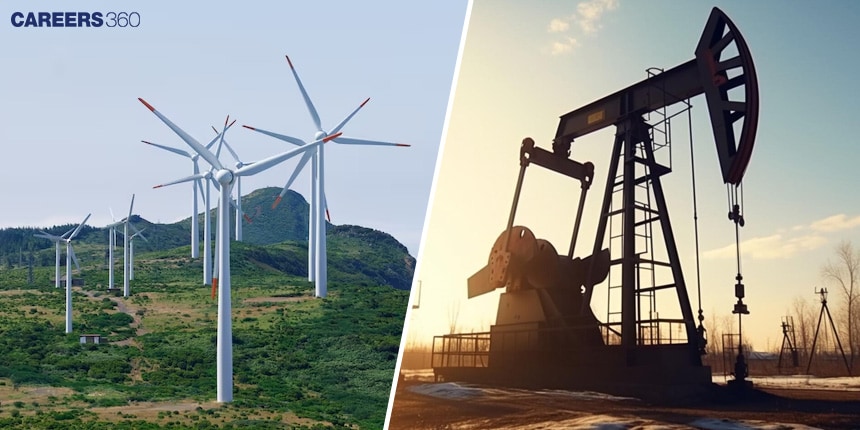Difference Between Renewable And Non-Renewable: : Types, Differences, Example, FAQs
Renewable and non-renewable resources differ in availability and renewal. Renewable resources, like solar and wind, are naturally replenished and sustainable, while nonrenewable resources such as coal, oil, and natural gas form over millions of years and are limited. The main difference between renewable and nonrenewable resources is that renewable ones are inexhaustible on a human timescale, while nonrenewable resources deplete and have a higher environmental impact. These are topics from environmental issues Biology.
This Story also Contains
- What are Renewable and Non-renewable Resources?
- Renewable Resources
- Non-renewable Resources
- Renewable Vs. Non-renewable Resources

What are Renewable and Non-renewable Resources?
These are essential elements or materials from our natural or human-made environment that provide value for human survival, development, and sustainability. Renewable and nonrenewable resources benefit the economy, support individual livelihoods, and are critical for ecosystem processes. These resources include minerals, water, forest resources, and energy sources necessary for industries, agriculture, and other human needs. Additionally, habitats play a vital role in maintaining species populations and ecosystem structures.
To distinguish between renewable and nonrenewable resources, we recognize that renewable resources such as sunlight, wind, and forests can regenerate over time, ensuring sustainability. Apart from this, non-renewable resources, like coal, natural gas, and minerals, cannot be replaced once depleted.
This difference between renewable and nonrenewable resources is crucial for effective resource management which ensures uninterrupted supplies for future generations. Differentiating between renewable and non-renewable energy resources helps us plan for a sustainable future and promotes the responsible use of resources.
Also Read
Renewable Resources
Renewable resources are those which can be replenished in a short span and usually do not have a fixed source and are available in nature. As opposed to non-renewable resources they have a long-term availability and serve towards reducing environmental degradation.
Types of Renewable Resources
Solar Energy: Collecting energy directly from the light source as sunlight, with the help of photovoltaic cells. Solar panels help absorption of the light and then generate power in the form of electricity.
Wind Energy: Turbing or using the wind generator which captures the kinetic energy of wind and then converts it into electricity.
Hydropower: Electrical power production through the conversion of water energy with the help of dams and turbines.
Biomass: The raw materials that include but are not limited to woods, crops, and wastes as they can be used to develop energy typically through combustion or biochemical conversion.
Geothermal Energy: Borrowing the heat energy from deep layers of the earth for generating electricity or for direct heating.
Non-renewable Resources
Non-renewable sources are limited and are formed through geophysical processes that may take millions of years. When used up, it is clear that the supplies are non-renewable, within human or many human life spans implying the resources are exhaustible in the long run.
Types of Non-renewable Resources
Fossil Fuels: Fossil fuels such as coal, oil and natural gases are found to be formed from plants and animal remains.
Nuclear Energy: Produced as a result of nuclear processes in substances like uranium or plutonium.
Renewable Vs. Non-renewable Resources
Aspect | Renewable Resources | Non-renewable Resources |
Energy Security | Promotes energy independence and security | Vulnerable to geopolitical tensions and supply disruptions |
Definition | Can be replenished naturally over a short period | Finite and take millions of years to form |
Examples | Solar energy, wind energy, hydropower, biomass, geothermal energy | Fossil fuels (coal, oil, natural gas), nuclear energy |
Sustainability | sustainable over the long term | Exhaustible over the long term |
Environmental Impact | Generally lower emissions and environmental impact | Higher emissions and environmental impact |
Availability | Abundant and widely distributed | Limited and concentrated in specific regions |
Usage | Increasingly used for electricity generation, heating, and transport | Predominantly used for electricity generation, industrial processes, and transportation |
Cost Trends | Decreasing costs due to technological advancements and scalability | Costs influenced by extraction, processing, and geopolitical factors |
Long-term Viability | Essential for sustainable development goals | Transition to alternatives required for sustainability |
Also Read
Frequently Asked Questions (FAQs)
Some of these are; solar energy, wind energy, hydropower, biomass, and geothermal energy. Photovoltaic cells are used in solar energy to convert the sun’s energy while wind power employs wind turbines. Hydropower involves the conversion of flowing water to electricity, biomass relies on organic materials to produce energy while geothermal energy is extracted from the earth’s heat.
The sources include fossil fuels (coal, oil, natural gas), and nuclear and the associated negative effects are air and water pollution, loss of habitats and greenhouse gases. They cause negative environmental impacts, pollute the ecosystem, decrease the levels of biological diversity, and influence people’s health adversely.
People can encourage the use of renewable energy by installing solar panels in houses, buying power from renewable sources, pushing for policies on the use of renewable energy, and observing power conservation. The utilisation of localised renewable energy projects and funding of green technology also reduces the shift of the dependency on energy.
Renewable means something can be replaced in a short time while on the other hand, non-renewable requires millions of years to develop. Renewable resources mainly reflect lower emission values and thus are part of sustainable development while on the other, side non-renewable resources increase the emission levels and thus have negative environmental impacts.
Renewable energy is essential to decrease the emission of greenhouse gases, improve energy security and address climate change. They are also sustainable because they reduce reliance on oil and gas and support the emergence of new climate technologies.